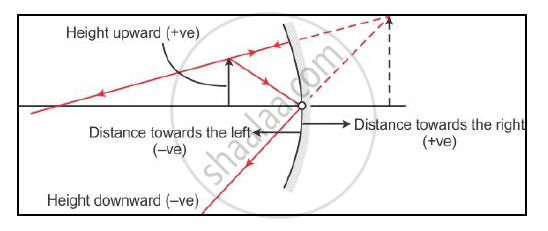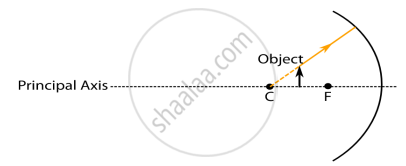Advertisements
Advertisements
प्रश्न
With the help of an appropriate ray diagram, state the sign conventions for reflection by a spherical mirror.
उत्तर
The sign convention for reflection by spherical mirrors is as follows:-

- The object is always placed to the left of the mirror.
- All distances parallel to the principal axis are measured from the pole of the mirror.
- All the distances measured to the right of the origin are taken as positive, while those measured to the left of the origin are taken as negative.
- Distances measured perpendicular to and above the principal axis are taken as positive.
- Distances measured perpendicular to and below the principal axis are taken as negative.
- The focal length of a convex mirror is positive, while that of a concave mirror is negative.
APPEARS IN
संबंधित प्रश्न
Draw a ray diagram for concave mirror when the object is between centre of curvature and focus.
If the image formed by a mirror for all positions of the object placed in front of it is always erect and diminished, what type of mirror is it? Draw a ray diagram to justify your answer. Where and why do we generally use this type of mirror?
Draw a ray diagram to show the path of the refracted ray in each of the following cases:-
A ray of light incident on a concave lens is
(i) passing through its optical centre.
(ii) parallel to its principal axis.
(iii) directed towards its principal focus.
It is desired to obtain an erect image of an object, using concave mirror of focal length of 12 cm.
What should be the range of distance of an object placed in front of the mirror?
To determine the approximate value of the focal length of a given concave mirror, you focus the image of a distant object formed by the mirror on a screen. The image obtained on the serene, as compared to the object is always:
(a) Laterally inverted and diminished
(b) Inverted and diminished
(c) Erect and diminished
(d) Erect and highly diminished
State two positions in which a concave mirror produces a magnified image of a given object. List two differences between the two images.
Draw ray diagrams to show the principal focus of a concave mirror.
Draw diagram to represent the action of a concave mirror on a beam of parallel light rays. Mark on this diagram principal axis, focus F, centre of curvature C, pole P and focal length f, of the concave mirror.
For what position of an object, a concave mirror forms a real image equal in size to the object?
Copy this figure in your answer book and show the direction of the light ray after reflection:
Which kind of mirror is used in the headlights of a car? Why is it used for this purpose?
Explain why, concave mirrors are used as shaving mirrors.
The real image formed by a concave mirror is larger than the object when object is:
(a) at a distance equal to radius of curvature
(b) at a distance less than the focal length
(c) between focus and centre of curvature
(d) at a distance greater than radius of curvature
The real image formed by a concave mirror is smaller than the object if the object is:
(a) between centre of curvature and focus
(b) at a distance greater than radius of curvature
(c) at a distance equal to radius of curvature
(d) at a distance equal to focal length
Giving reasons, state the 'signs' (positive or negative) which can be given to the following:
(a) object distance (u) for a concave mirror or convex mirror
(b) image distance (v) for a concave mirror
(c) image distance (v) for a convex mirror
What is the position of the image when an object is placed at a distance of 20 cm from a concave mirror of focal length 20 cm?
How far should an object be placed from the pole of a converging mirror of focal length 20cm to form a real image of the size exactly `1/4`th the size of the object?
An object is 24 cm away from a concave mirror and its image is 16 cm from the mirror. Find the focal length and radius of curvature of the mirror, and the magnification of the image.
An object is placed at a large distance in front of a concave mirror of radius of curvature 40 cm. The image will be formed in front of the mirror at a distance:
(a) 20 cm
(b) 30 cm
(c) 40 cm
(d) 50 cm
What would your image look like if you stood close to a large:
concave mirror?
The mirror used by a dentist to examine the teeth of a person is:
(d) any one of the above
(a) convex
(b) concave
(c) plane
(d) any one of the above
A real image of an object is to be obtained. The mirror required for this purpose is:
(a) convex
(b) concave
(c) plane
(d) either convex or concave
With the help of a labelled diagram, explain how a concave lens diverges a beam of parallel light rays. Mark the principal axis, optical centre, principal focus and focal length of the concave lens on the diagram.
If the radius of curvature of a concave mirror is 20 cm, its focal length is:
Draw a ray diagram to show the formation of image of an object placed between the focus and centre of curvature of a concave mirror. State the position, size and nature of the image.
A student obtained a sharp image of the grills of a window on a screen using a concave mirror. His teacher remarked that for getting better results a well lit distant object (preferably the sun) should be focussed on the screen. What should be done for this purpose?
(A) Move the screen slightly away from the mirror
(B) Move the mirror slightly towards the screen
(C) Move the screen and the mirror away from the object
(D) Move the screen and the mirror towards the object
To construct ray diagram we use two light rays which are so chosen that it is easy to know their directions after reflection from the mirror. List these two rays and state the path of these rays after reflection. Use these rays to locate the image of an object placed between centre of curvature and focus of a concave mirror.
Draw the ray diagram and also state the position, the relative size and the nature of image formed by a concave mirror when the object is placed at the centre of curvature of the mirror.
To find the focal length of a concave mirror Rahul focuses a distant object with this mirror. The chosen object should be
(1) a tree
(2) a building
(3) a window
(4) the sun
Answer the following question:
An object is placed at a distance of 30 cm from a concave lens of focal length 30 cm.
(i) Use the lens formula to determine the distance of the image from the lens.
(ii) List four characteristics of the image (nature, position, size, erect/inverted) in this case.
(iii) Draw a labelled diagram to justify your answer of the part (ii)
Explain the images formed by a concave mirror.

While looking at the above diagram, Nalini concluded the following.
- the image of the object will be a virtual one.
- the reflected ray will travel along the same path as the incident ray but in opposite direction.
- the image of the object will be inverted.
- this is a concave mirror and hence the focal length will be negative.
Which one of the above statements are correct?
In the headlights of motor vehicles, ______ mirrors are used as reflectors.
